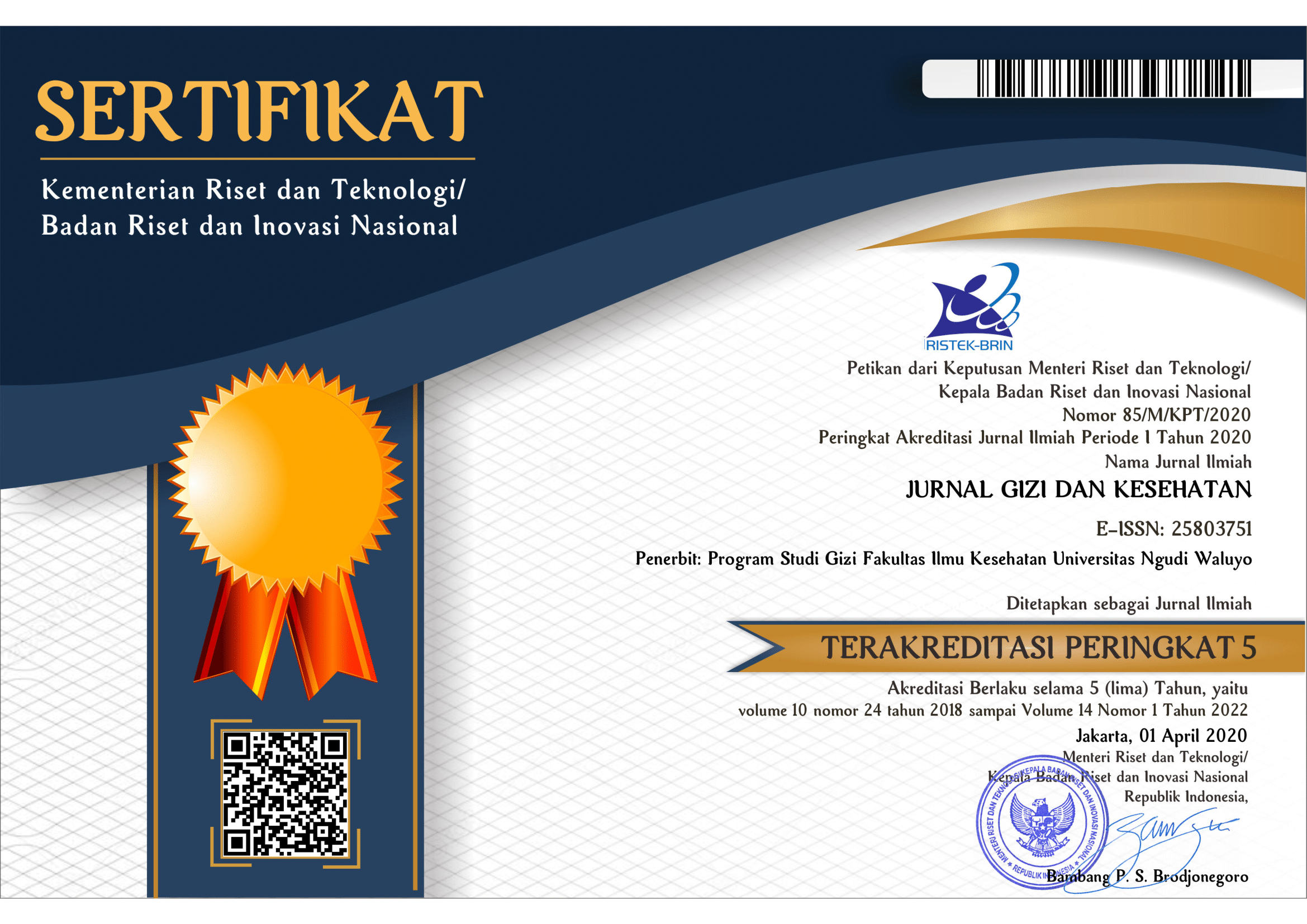The Effect of Fermentation on The Nutrients of Processed Cowpea (Vigna unguiculata l. Walp)
DOI:
https://doi.org/10.35473/jgk.v13i2.237Keywords:
Fermentation, Nutrients, CowpeaAbstract
Cowpea is a type of legume in Indonesia but utilization not optimal. Cowpea can be used as a basic of making tempeh. The purpose of the study is to know the effect of fermentation on the nutrients of processed cowpea. The design of the study was Pra Eks/imen Design with Completely Randomized Design in laboratory to test nutrients which were repeated 3 times. Data analysis used SPSS (Statistical Product Service Solution) application. The measurement of carbohydrate used anthron method, crude fiber used refluks method, total protein used kjeldhal method, and fat used soxhlet method. Nutrients of boiled cowpea is carbohydrate content of 31,21%; crude fiber content of 13,94%; total protein content of 26,71% and fat content of 7,35%. Nutrients of cowpea tempeh is carbohydrate content of 26,71%; crude fiber content 17,21%; total protein content of 15,38% and fat content of 1,44%. There are not statistical different nutrients of boiled cowpea and tempeh cowpea, but different values
Downloads
References
Badan Penelitian Tanaman Aneka Kacang dan Umbi. (2016). “Deskripsi Varietas Kacang Tunggak”. http://balitkabi.litbang./tanian.go.id/wp-content/uploads/2016/09/kacangtunggak.pdf. [15 Juli 2020].
Badan Pusat Statistik. (2019). “Impor Kedelai Menurut Negara Asal Utama, 2010-2019”. https://www.bps.go.id/statictable/2019/02/14/2015/impor-kedelai-menurut-negara-asal-utama-2010-2019.html. [8 Mei 2020].
Badan Standardisasi Nasional. (2009). SNI 3144:2009 Tempeh Kedelai.
Deliani. (2008). “Pengaruh Lama Fermentasi terhadap Kadar Protein, Lemak, Komposisi Asam Lemak dan Asam Fitat pada Pembuatan Tempeh”. Tesis Program Studi Ilmu Kimia pada Sekolah Pascasarjana Universitas Sumatera Utara.
Dewi, IWR. (2010). “Karakteristik Sensoris, Nilai Gizi dan Aktivitas Tempeh Kacang Gude (Cajanus cajan (L.) Millsp.) dan Tempeh Kacang Tunggak (Vigna unguiculata (L.) Walp.) dengan Berbagai Variasi Waktu Fermentasi”. Skripsi Teknologi /tanian Fakultas /tanian Universitas Sebelas Maret.
EC, O. (2016). "Effect of Boiling, Pressure Cooking and Germinationon the Nutrient and Antinutrients Content of Cowpea (Cigna unguiculata)". Food Science & Nutrition Technologi, 1(1),PP. 1-8.
Ratnaningsih N; Nugraheni M. and Rahmawati F. (2009). “Pengaruh Jenis Kacang Tolo, Proses Pembuatan dan Jenis Inokulum Terhadap /ubahan Zat-Zat Gizi pada Fermentasi Tempeh Kacang Tolo”. Jurnal Penelitian Saintek, 14(1), pp. 97–128.
Ratnaningsih, N. (2007). "/ubahan Kadar Protein Total dan Protein Tercerna Selama Proses Fermentasi Tempeh Kacang Tolo". Jurnal Penelitian Saintek, Vol. 12, No. 1, April 2007 : 35-54.
Pagarra H. (2011). “Pengaruh Lama /ebusan terhadap Kadar Protein Tempeh Kacang Tunggak (Vigna Unguiculata)”. Bionature; Vol. 12 (1): Hlm: 15-20, April 2011.
Kementerian Kesehatan RI. (2018). Tabel komposisi Pangan Indonesia 2017. Jakarta : Direktorat Jenderal Kesehatan Masyarakat, Direktorat Gizi Masyarakat.










